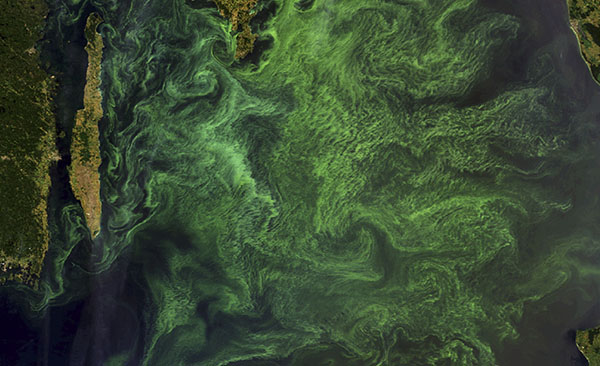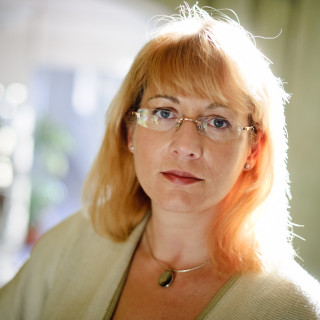Historical oxygen depletion in Baltic sediment – a consequence of human impact?
The exploitation of the earth over the past hundred years, in combination with climate change, is leaving its mark in the sediment in the depths of the sea, in the form of dead seabeds. When the researchers look deeper down into the sediment, it emerges that periods of oxygen depletion have occurred earlier in the Baltic Sea’s history. Was this a natural phenomenon or have humans been involved before?
The sediment of the Baltic Sea serves as a reference library where researchers can read sediment layer after sediment layer, going thousands of years back in time. The sediment shows that, over the past 2 000 years, there have been periods with and without oxygen depletion. At first glance, the oxygen conditions may appear to vary with fluctuations in the climate; a warmer climate leads to greater productivity in the sea and thus the use of more oxygen from the sediment, while there is less oxygen dissolved in the water.
When researchers from the Department of Geology at Lund University started investigating whether there were other links that could explain variations in oxygen levels, almost ten years ago, they realised that they were facing a complex problem. Many different factors may have interacted, and one important factor when looking at the changes over the past 2 000 years could be human activity.
Increase and change in land use triggered eutrophication?
Two thousand years ago, the oxygen conditions on the bed of the Baltic Sea were good, but a few hundred years later, areas of oxygen depletion appeared, visible as black layers in the sediment samples. During the late Iron Age (400–1050 AD), people began to keep animals in stables in the relatively mild climate and to fertilise the ground. There are signs that nearby lakes were already being affected by increasing nutrient leaching. The researchers speculate on whether this small increase in nutrient supply to the sea – in combination with a gradually warming climate – may even have triggered the oxygen depletion.
Over the following three centuries, up until the 14th century, the population around the Baltic Sea doubled as a result of improved cultivation techniques. A plough with a mouldboard came into use, which led to increased erosion and nutrient loss. A growing population in combination with a new cultivation system, where the fields sometimes lay fallow, led to the clearing of more land. This expansion may have led to a significant increase in leaching of nutrients into the Baltic.
The Black Death – saviour of the sea?
The situation then changed, and lighter layers can be seen once again in the sediment samples. At some point around 700 years ago, the bed of the Baltic Sea must have become oxygenated again.
“In the Baltic Sea, the areas of oxygen depletion have increased so much, that it definitely cannot be attributed to a natural phenomenon.”
On land, the conditions at that time were less favourable. The climate became cooler and plagues swept across Europe, killing large swathes of the population. Between the years 1300 and 1413, the population of Sweden is estimated to have fallen from over a million to around 350 000 as a result of famine and the ravages of the Black Death. In some settlements, there was no one left to cultivate the land, and fields returned to forest.
In conjunction with these changes, nutrient leaching should have fallen dramatically. In the cooler climate, the reduction may have been sufficient to give the Baltic seabed chance to recover.
Natural phenomenon or human impact?
Over recent decades, the seas have again begun to show signs that something is wrong. Down in the depths, the dead seabeds are expanding and research reveals that we have never had such large areas of oxygen depletion in the world’s oceans as now. Most researchers agree that the expansion of the oxygen-depleted seabeds has been accelerated by the eutrophication of the past century.
“In the Baltic Sea, the areas of oxygen depletion have increased so much, that it definitely cannot be attributed to a natural phenomenon”, says Johanna Stadmark, project assistant for the Multistressors research environment at Lund University.
Could it be the case that humans left their mark not only on land, but also in the Baltic Sea when they began to clear land, cultivate crops and keep animals?
“We believe so”, says Johanna Stadmark, “and we therefore want to study this more closely in future projects. We want to calculate the amount of nutrients that could have leached into the sea with the land use and population size in the 13th century, for example. Then we can use today’s models to see whether this leaching could affect the oxygen levels on the bed of the Baltic Sea sufficiently to cause oxygen depletion.”
Text: Pia Romare
Published: 2014
Facts
-
Multistressors
-
The project ‘Managing Multiple Stressors in the Baltic Sea’ (Multistressors) is a research environment at Lund University. Researchers from three departments work together and combine palaeo-based methods with ecological methods, terrestrial biogeochemistry and modelling to tackle problems in the past, present and future. Among other things, they study historical occurrences of oxygen depletion in order to understand what impact humans have had on the Baltic Sea over the past 2 000 years.
-
Historical archive
-
Researchers can remove long cores of untouched sediment from the deep areas where the sediment accumulates. The layers can be dated and their appearance may indicate oxygen depletion. The amount of organic coal remaining can be analysed to assess how nutrient-rich the water was, and the presence of various shell remains from microscopic plants and animals can provide a picture of what the environment was like at that time.
-
Eutrophication and oxygen depletion
-
The release of large quantities of nutrients, primarily phosphorus and nitrogen, lead to eutrophication in the Baltic Sea. Nutrient release over the past six decades has primarily come from artificial fertiliser, large-scale animal farming, burning of fossil fuels and discharge from public water works. Eutrophication leads to oxygen depletion and large blooms of cyanobacteria, commonly known as algal blooms. A lot of oxygen is required to break down the dead cyanobacteria that sink to the seabed. When only a small amount of oxygen remains, the sediment on the seabed begins to release phosphorus. More phosphorus in the water leads to further blooms and a vicious circle arises.









